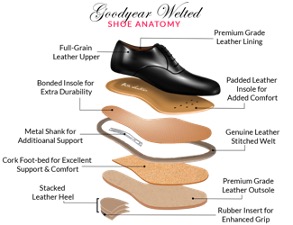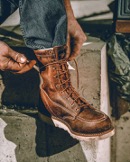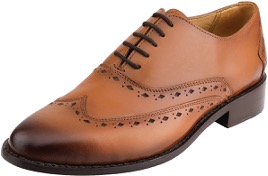When you are looking for a shoe that will be durable over time, whether it’s a corporate shoe or work boots, then a welted shoe is what you are looking for.

There are various methods of shoe construction, injection molding, cement construction, or welted construction.
In this article, we are going to analyze the two most adopted shoe welts, Storm Welt and Goodyear Welt.
By the end of this article, I hope you’d have found the one that fits you best.
What is a Shoe Welt?
Table of Contents
Before we dive into these two welts, it’s important you really understand what a shoe welt is. Shoe manufacturers use this word to sell lots of shoes and so many men don’t really know what it means.
However, to understand what it means, we have to explain the parts that all shoes are made of.
There are three major parts of a complete shoe.
The Upper
This is the beautiful part of the shoe that covers your foot. It is where you put your foot, which could be made of leather, rubber, suede, canvas, etc. It could come with lace or not.
The Insole
The insole is the layer inside the upper of your shoe, where your foot rests. It is in between the upper and the sole, made to provide comfort and absorb shock.
The Sole
The sole is the bottom part of the shoe, also known as the outsole. It is the entire part of the shoe under the wearer’s foot and insole.
It is where you match on the ground, and sometimes, heels are attached to the sole.
So with that out of the way, did you know that not all shoes are constructed with just the upper, sole, and insole joined together?
Dating back centuries ago, manufacturers of top classic shoes usually add another layer in between the insole and the outsole, usually made of leather, which is then sewn together using special machines.
This extra layer in-between, O-ringed in design, that serves as a gasket for the sole and insole, which runs around the parameter of your boot/shoe, is called the Shoe Welt.
Now that you know what a welt means, let’s dive into the main article.
What is Goodyear Welt?
The Goodyear welt process, dating back as far as the 1860s, is one of the oldest forms of welting shoes using machines.
In 1875, Charles Goodyear, with the help of mechanics invented the machine that would be able to stitch the upper, soles, and welt of a shoe without hand sewing.
The machine used a curved needle and awl to sew the welts into the insole on the go, without taking them (the needle and awl) off, while not penetrating the insole as well.
Goodyear would go on to secure a patent for this amazing machine, using his name for the product.
This is how the Goodyear welt works;

A Goodyear welt could be a strip of leather, plastic, or rubber that is attached around the perimeter of the insole of the shoe.
When the welt is added, there will be a space between the sole and insole. The space created by the Goodyear welt is then filled with various filler materials of the manufacturer’s choice.
The filler could be cork, foams, or anything that is either porous or not so hard – usually soft (this is meant to provide a cushioning and breathability for the shoe)
After the space has been filled, the outsole is then added and stitched to the welt using special sewing machines and high-strength adhesives, like hide glue, etc.
There are many pros and cons to these methods, which we will talk about in the coming sections.
What Does Storm Welt Mean?

Now, this is where it becomes confusing. When you look at Goodyear dress shoes like the Lethato Captoe Oxford shoes, they look very similar to the Goodyear welted design.
However, the Stormwelt is a bigger welt than the Goodyear welt. It comes with a wider width and a taller height.
Storm welt also comes in leather or rubber materials.
Also, they run 360 degrees around the insole than most Goodyear welts – which only goes three-quarters around the back of the sole.
Some leather Goodyear welts also run 360 degrees around the shoe.
Because of the thickness of Storm Welt, they are usually found in most heavy-duty boots.
In a Storm welt stitching process, the upper, the welt, and the insole is gripped better as a result of its bigger and wider size.
Although, most people might confuse a Storm welt for a Good year welt when you see or read welts described as “Storm Goodyear welt construction” on boots/shoe adverts, know they are referring to the Storm welt.
The Storm welt has its pros and cons, which we will discuss in the coming sections.
Now let’s talk about the differences between both welts.

What Are The Differences Between Goodyear Welt And Storm Welt?
As we have mentioned, it is usually tricky for men to spot the difference between a Goodyear welt and a Storm welt.

A storm welt construction overview
I am going to reveal some of their major differences to you;
Storm welt is bigger than Goodyear welt
This is arguably the most spotted difference between both welts.
The width and height give the Storm welt more space to bend upwards, which creates a strong seal around the part that the upper and insole(or mid-sole) connect.
Goodyear welts are lighter than Storm welt
While the adding of a welt to a boot/shoe design calls for filler materials like cork or foams, the Goodyear welt requires less filler padding than the Storm welt.
The Storm welt makes a boot/shoe chunkier and heavier than the Goodyear welt. This could be an advantage or disadvantage depending on what you need the shoes for.
Fortunately, the wider and taller size of a Storm welt is popularly considered to give it a more authentic look, better suited for heavy-duty boots than the Goodyear welt.
Storm welt can be more water-resistant than Goodyear welt
Because of its wider sizes, taller heights, and firmer grip, the Storm welt serves as a better waterproof than the Goodyear welt.
The Storm welt offers greater protection against moisture than its counterpart.
Also, its 360 degrees perimeter offers more coverage than most Goodyear welts that have just three-quarters of the shoe covering, usually at the back down to the half of both sides of the shoes.
Goodyear welted shoes can be worn for longer in the day than Storm welt shoes
Because of its light-weighted feature, the Goodyear welt is usually used for more regular and classic shoes than the Storm welt.
Almost all corporate leather or suede shoes with high quality are Goodyear welted, while Storm Welt is majorly common among boots – mostly heavy-duty boots.
And some boots are designed with the Goodyear welt too!
What are the Similarities Between Goodyear Welt and Storm Welt?
Goodyear welt and Storm welt are mostly similar. Other than the fact that Storm welts are bigger than Goodyear welts, they both serve the same purpose.
Here are some of their similarities:
They both bind the outsole tightly to the insole
This is the major reason they were made in the first place. Welt, we’re created so shoes could be more durable.
Welts provide an extra layer for the insole to stick to with the outsole, making the shoes last for many years.
Generally, both the Storm Welt and Goodyear welt increase the durability of any shoe that has it. A welted shoe is designed to last.
Both Welts make shoes waterproof
Yeah, it all still boils down to the binding they provide.
There are various constructions of shows which do not offer water resistance. Blake stitch for example just attaches the outsole directly to the insole.
This kind of design leaves pores in between the soles and water can easily enter the shoes.
However, with a Goodyear welt or Storm welt, these pores are removed.
These welts provide extra seals that leave no pores in-between the soles, so no liquid whatsoever can come in.
But… wait! That’s not to say you should start using your leathered Goodyear welt or Storm welt shoe as the traditional rain boots.
If your shoe has welts, you could walk in the rain for a short while or walk past through water pods without wetting your foot, but they won’t deliver the job of a real rain boot.
You can only be rest assured that it would be difficult for a welted shoe – Storm welt or Goodyear Welt – to be destroyed by water.
Goodyear welt and Storm welt are stitched by machines
Before machines were created, shoemakers did the welts by hand sewing. But after Charles Goodyear jr. invented the Goodyear welt machines, shoe manufacturers widely adopted the process of switching welts using welting machines.
Any welt that is stitched with the Goodyear welting machine is called a Goodyear welt.
While some shoemakers still welt shoes with their hands, talking about some 100% handmade shoes, the process is slow and tedious.
Goodyear welt and Storm welt are stitched with their various specialized sewing machines.
Is Storm Welt Better than Goodyear Welt?
Whether a Storm welt is better than a Goodyear welt, depends on you, the wearer.
Generally, when it comes to water resistance, durable sealing, and authenticity, Storm welt bests Goodyear we’re hands down.
The problem is that not everybody likes heavy shoes, and Storm welts make shoes/boots heavier.
Goodyear welt on the other hand, while not wider or sturdier than Storm welt, still fully serves the purpose of a shoe welt.
It connects the soles so tightly to prevent any form of pores, making the shoe water-resistant. That’s what a good welt should do.
And Goodyear welted shoes are lighter. Everybody likes light shoes.
If you don’t have a problem with a shoe/boot being a bit chunkier than normal, and you’d rather go for the best protection, then Storm Welt is best for you.
But if you are like me, who is allergic to anything with heavy boots or shoes, then Goodyear would be better in this case.
So…
Can You Re-sole A Storm Welt?

You can change your storm welt sole in a shoe repair shop.
Yes. One good thing about Storm welt – or any welt – is that when the thread wears out, it can be pulled apart and re-sewn.
Also, if the sole has worn out, the welt makes it easy to remove the sole and another one can be attached without affecting any part of the main shoe.
But don’t do it yourself, give it to a cobbler or shoe repair shop.
How Many Times Can A Shoe Be Resoled?
Typically, you can keep changing the sole as long as you want. Although, most shoe repair shops would allow for up to 2 to 3 times max.
Nevertheless, if the shoe upper and insole is still in good condition, you can keep resoling, perhaps at a different cobbler.
Resoling is what makes welted shoes life-saving, you could wear them for years.
Can A Boot Sole Be Replaced?
Boots are generally durable. Both the upper, insole, and outsole are durable for years and are also very difficult to wear out.
If the welt thread starts to lose or the boot heel starts peeling off, you can keep replacing the boot sole indefinitely.
You can as well replace the welt with a new welt of your choice, while resoling.
Which Welt Should You Go For and Why?
The welt to go for would depend on where you are going to use them, either indoors or outdoors.
Indoors

If you work in an office, you know, if you wear your shoes with suits or corporate wear, you should go with a shoe that has Goodyear welt.
It’s lighter to use since you are not outdoor working in the mud or factories.
Do you really need any extra water resistance, especially if you are not likely to find yourself in the rain regularly?
No, you’d have to go for the Goodyear welt shoes.
Outdoors
![]()
Storm welt boots/shoes are great for outdoor activities.
If you work outdoors, like a farmer, engineer, or even miner, then you’d need a heavy-duty boot for the job.
A Storm-welt shoe would be the best for the job.
Since if you’d be outdoor most of the time you would really need the extra grip, the extra water resistance, and durability.
And also Storm welted shoes are usually boots, which are majorly used by heavy-duty workers.
A Storm welted shoe is great for outdoor workers.
In Conclusion
Here you have it!
Storm welt vs Goodyear welt.
I hope you’ve been able to settle on which welt you’d need to go for?
Happy Shopping.
Related:
